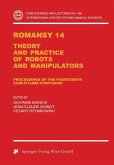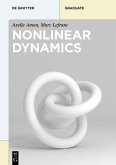Nonlinear Dynamics
Mathematical Models for Rigid Bodies with a Liquid
Übersetzung:Malyshev, Peter V.
Nonlinear Dynamics
Mathematical Models for Rigid Bodies with a Liquid
Übersetzung:Malyshev, Peter V.
- Gebundenes Buch
- Merkliste
- Auf die Merkliste
- Bewerten Bewerten
- Teilen
- Produkt teilen
- Produkterinnerung
- Produkterinnerung
This book is devoted to analytically approximate methods in the nonlinear dynamics of a rigid body with cavities (containers) partly filled by a liquid. The methods are normally based on the Bateman-Luke variational formalism combined with perturbation theory. The derived approximate equations of spatial motions of the body-liquid mechanical system (these equations are called mathematical models in the title) take the form of a finite-dimensional system of nonlinear ordinary differential equations coupling quasi-velocities of the rigid body motions and generalized coordinates responsible for…mehr
![Romansy 14 Romansy 14]() Romansy 1474,99 €
Romansy 1474,99 €![Nonlinear Dynamics Nonlinear Dynamics]() Axelle AmonNonlinear Dynamics54,95 €
Axelle AmonNonlinear Dynamics54,95 €![Ergodic Theory Ergodic Theory]() Idris AssaniErgodic Theory102,99 €
Idris AssaniErgodic Theory102,99 €![Schur-Convex Functions and Inequalities Schur-Convex Functions and Inequalities]() Huan-nan ShiSchur-Convex Functions and Inequalities159,95 €
Huan-nan ShiSchur-Convex Functions and Inequalities159,95 €![Handbook of Fractional Calculus with Applications, Basic Theory Handbook of Fractional Calculus with Applications, Basic Theory]() Handbook of Fractional Calculus with Applications, Basic Theory169,95 €
Handbook of Fractional Calculus with Applications, Basic Theory169,95 €![Schur-Convex Functions and Inequalities Schur-Convex Functions and Inequalities]() Huan-nan ShiSchur-Convex Functions and Inequalities113,99 €
Huan-nan ShiSchur-Convex Functions and Inequalities113,99 €![Fractional Signals and Systems Fractional Signals and Systems]() Manuel Duarte OrtigueiraFractional Signals and Systems106,99 €
Manuel Duarte OrtigueiraFractional Signals and Systems106,99 €-
-
-
The book can be useful for both experienced and early-stage mechanicians, applied mathematicians and engineers interested in (semi-)analytical approaches to the "fluid-structure" interaction problems, their fundamental mathematical background as well as in modeling the dynamics of complex mechanical systems containing a rigid tank partly filled by a liquid.
- Produktdetails
- De Gruyter Studies in Mathematical Physics 27
- Verlag: De Gruyter
- Seitenzahl: 410
- Erscheinungstermin: 17. April 2015
- Englisch
- Abmessung: 246mm x 175mm x 28mm
- Gewicht: 814g
- ISBN-13: 9783110316551
- ISBN-10: 3110316552
- Artikelnr.: 41068087
- De Gruyter Studies in Mathematical Physics 27
- Verlag: De Gruyter
- Seitenzahl: 410
- Erscheinungstermin: 17. April 2015
- Englisch
- Abmessung: 246mm x 175mm x 28mm
- Gewicht: 814g
- ISBN-13: 9783110316551
- ISBN-10: 3110316552
- Artikelnr.: 41068087
Introduction
1. Governing equations and boundary conditions in the liquid sloshing dynamics
1.1. Conservation laws and basic hydrodynamic equations
1.2. Links between the stress tensors and the strain rate
1.3. Governing equations for the contained liquid motions
1.4. Boundary and initial conditions
1.5. The free-surface sloshing problem in a curvilinear coordinate system
2. The Bateman-Luke variational principle and associated projective methods in the dynamics of a rigid tank partly filled by a liquid
2.1. Variational formulation of sloshing problem in a motionless container
2.2. Projective (multimodal) methods for sloshing problem in a motionless container with upright walls in a neighborhood of the free surface
2.3. Generalizing the multimodal methods for complex tank shapes
2.4. Variational formulation and modal equations in a linear approximation
2.5. The Bateman-Luke variational formulation of sloshing problem for prescribed spatial tank motions
2.6. Projective approximate (multimodal) method in sloshing problem for prescribed spatial tank motions
2.7. Variational formulation of the Stokes-Joukowski potentials problem
2.8. Hydrodynamic force and moment5
2.9. The Bateman-Luke variational formulation and related projective (multimodal) method for the coupled `rigid tank-contained liquid' dynamics
3. Nonlinear approximate (modal) equations for sloshing a rigid upright circular (annular) cylindrical tank
3.1. Nonlinear approximate modal equations for sloshing in an upright cylindrical tank of circular and annular cross-sections
3.2. Generalizing the nonlinear modal equations for a dissipative incompressible liquid within the framework of the Newton dissipation hypothesis
3.3. Computing the hydrodynamic coefficients of the nonlinear modal equations when the tank has a uniform axisymmetric bottom
3.4. Computing the hydrodynamic coefficients of the nonlinear modal equations for an upright cylindrical tank of elliptical cross-section
3.5. The Stokes-Joukowski potentials for an upright annular cylindrical tank
3.6. Expressions for the inertia tensor and other hydrodynamic parameters
3.7. Scalar-form equations for the tank-liquid dynamics in particular cases
3.8. Nonlinear approximate equations of weakly-perturbed motions of the tank-liquid mechanical system in the case of an upright circular cylindrical tank
4. Nonlinear approximate modal equations for sloshing in non-cylindrical axisymmetric containers
4.1. Natural sloshing modes for a conical tank
4.2. Nonlinear modal equations for sloshing in a conical tank
4.3. A single-dimensional modal equation for sloshing in a spherical tank
5. Nonlinear approximate modal equations of the tank-liquid dynamics derived by utilizing the perturbation theory6
5.1. Reducing the nonlinear sloshing problem to a series of linear boundary value problemsPreface
Introduction
1. Governing equations and boundary conditions in the liquid sloshing dynamics
1.1. Conservation laws and basic hydrodynamic equations
1.2. Links between the stress tensors and the strain rate
1.3. Governing equations for the contained liquid motions
1.4. Boundary and initial conditions
1.5. The free-surface sloshing problem in a curvilinear coordinate system
2. The Bateman-Luke variational principle and associated projective methods in the dynamics of a rigid tank partly filled by a liquid
2.1. Variational formulation of sloshing problem in a motionless container
2.2. Projective (multimodal) methods for sloshing problem in a motionless container with upright walls in a neighborhood of the free surface
2.3. Generalizing the multimodal methods for complex tank shapes
2.4. Variational formulation and modal equations in a linear approximation
2.5. The Bateman-Luke variational formulation of sloshing problem for prescribed spatial tank motions
2.6. Projective approximate (multimodal) method in sloshing problem for prescribed spatial tank motions
2.7. Variational formulation of the Stokes-Joukowski potentials problem
2.8. Hydrodynamic force and moment5
2.9. The Bateman-Luke variational formulation and related projective (multimodal) method for the coupled `rigid tank-contained liquid' dynamics
3. Nonlinear approximate (modal) equations for sloshing a rigid upright circular (annular) cylindrical tank
3.1. Nonlinear approximate modal equations for sloshing in an upright cylindrical tank of circular and annular cross-sections
3.2. Generalizing the nonlinear modal equations for a dissipative incompressible liquid within the framework of the Newton dissipation hypothesis
3.3. Computing the hydrodynamic coefficients of the nonlinear modal equations when the tank has a uniform axisymmetric bottom
3.4. Computing the hydrodynamic coefficients of the nonlinear modal equations for an upright cylindrical tank of elliptical cross-section
3.5. The Stokes-Joukowski potentials for an upright annular cylindrical tank
3.6. Expressions for the inertia tensor and other hydrodynamic parameters
3.7. Scalar-form equations for the tank-liquid dynamics in particular cases
3.8. Nonlinear approximate equations of weakly-perturbed motions of the tank-liquid mechanical system in the case of an upright circular cylindrical tank
4. Nonlinear approximate modal equations for sloshing in non-cylindrical axisymmetric containers
4.1. Natural sloshing modes for a conical tank
4.2. Nonlinear modal equations for sloshing in a conical tank
4.3. A single-dimensional modal equation for sloshing in a spherical tank
5. Nonlinear approximate modal equations of the tank-liquid dynamics derived by utilizing the perturbation theory6
5.1. Reducing the nonlinear sloshing problem to a series of linear boundary value problems5.2. Vector-form equations for the tank-liquid dynamics
5.3. Basic boundary value problems for axisymmetric tanks having an upright walls in the vicinity of the free surface
5.4. Scalar-form equations for the tank-liquid dynamics in the case of axisymmetric tanks with upright walls in the vicinity of the free surface; the hydrodynamic coefficients in particular cases
5.5. Solving the basic boundary value problems and computing the hydrodynamic coefficients in the case of an upright cylindrical tank of circular and annular cross-sections
5.6. Generalizing the perturbation technique for complex axisymmetric tank shapes
6. Equivalent mechanical systems in the nonlinear dynamics of a rigid tank partly filled by a liquid
6.1. Nonlinear approximate modal equations for sloshing in an upright annular cylindrical tank due to translatory tank motions
6.2. Equivalent mechanical systems for the coupled tank-liquid dynamics in the case of an upright annular cylindrical tank
7. Forced finite-amplitude liquid sloshing in a mobile tank
7.1. The hydrodynamic instability of nonlinear steady-state liquid sloshing in an upright annular cylindrical tank due to harmonic translatory tank excitations
7.2. Studying the hydrodynamic instability of forced and parametric steady-state sloshing by using a simplified two-dimensional modal system
7.3. Constructing an approximate periodic solution of (7.2.1)
7.4. The Bubnov-Galerkin method for finding a time-periodic solution of (7.1.3)
7.5. Stability and instability of the time-periodic solution of (7.1.3)
7.6. Forced liquid sloshing due to harmonic angular tank excitations
7.7. Response curves
7.8. Damping effect
7.9. Hydrodynamic force and moment
7.10. Nearly steady-state sloshing regimes
Bibliography
Introduction
1. Governing equations and boundary conditions in the liquid sloshing dynamics
1.1. Conservation laws and basic hydrodynamic equations
1.2. Links between the stress tensors and the strain rate
1.3. Governing equations for the contained liquid motions
1.4. Boundary and initial conditions
1.5. The free-surface sloshing problem in a curvilinear coordinate system
2. The Bateman-Luke variational principle and associated projective methods in the dynamics of a rigid tank partly filled by a liquid
2.1. Variational formulation of sloshing problem in a motionless container
2.2. Projective (multimodal) methods for sloshing problem in a motionless container with upright walls in a neighborhood of the free surface
2.3. Generalizing the multimodal methods for complex tank shapes
2.4. Variational formulation and modal equations in a linear approximation
2.5. The Bateman-Luke variational formulation of sloshing problem for prescribed spatial tank motions
2.6. Projective approximate (multimodal) method in sloshing problem for prescribed spatial tank motions
2.7. Variational formulation of the Stokes-Joukowski potentials problem
2.8. Hydrodynamic force and moment5
2.9. The Bateman-Luke variational formulation and related projective (multimodal) method for the coupled `rigid tank-contained liquid' dynamics
3. Nonlinear approximate (modal) equations for sloshing a rigid upright circular (annular) cylindrical tank
3.1. Nonlinear approximate modal equations for sloshing in an upright cylindrical tank of circular and annular cross-sections
3.2. Generalizing the nonlinear modal equations for a dissipative incompressible liquid within the framework of the Newton dissipation hypothesis
3.3. Computing the hydrodynamic coefficients of the nonlinear modal equations when the tank has a uniform axisymmetric bottom
3.4. Computing the hydrodynamic coefficients of the nonlinear modal equations for an upright cylindrical tank of elliptical cross-section
3.5. The Stokes-Joukowski potentials for an upright annular cylindrical tank
3.6. Expressions for the inertia tensor and other hydrodynamic parameters
3.7. Scalar-form equations for the tank-liquid dynamics in particular cases
3.8. Nonlinear approximate equations of weakly-perturbed motions of the tank-liquid mechanical system in the case of an upright circular cylindrical tank
4. Nonlinear approximate modal equations for sloshing in non-cylindrical axisymmetric containers
4.1. Natural sloshing modes for a conical tank
4.2. Nonlinear modal equations for sloshing in a conical tank
4.3. A single-dimensional modal equation for sloshing in a spherical tank
5. Nonlinear approximate modal equations of the tank-liquid dynamics derived by utilizing the perturbation theory6
5.1. Reducing the nonlinear sloshing problem to a series of linear boundary value problemsPreface
Introduction
1. Governing equations and boundary conditions in the liquid sloshing dynamics
1.1. Conservation laws and basic hydrodynamic equations
1.2. Links between the stress tensors and the strain rate
1.3. Governing equations for the contained liquid motions
1.4. Boundary and initial conditions
1.5. The free-surface sloshing problem in a curvilinear coordinate system
2. The Bateman-Luke variational principle and associated projective methods in the dynamics of a rigid tank partly filled by a liquid
2.1. Variational formulation of sloshing problem in a motionless container
2.2. Projective (multimodal) methods for sloshing problem in a motionless container with upright walls in a neighborhood of the free surface
2.3. Generalizing the multimodal methods for complex tank shapes
2.4. Variational formulation and modal equations in a linear approximation
2.5. The Bateman-Luke variational formulation of sloshing problem for prescribed spatial tank motions
2.6. Projective approximate (multimodal) method in sloshing problem for prescribed spatial tank motions
2.7. Variational formulation of the Stokes-Joukowski potentials problem
2.8. Hydrodynamic force and moment5
2.9. The Bateman-Luke variational formulation and related projective (multimodal) method for the coupled `rigid tank-contained liquid' dynamics
3. Nonlinear approximate (modal) equations for sloshing a rigid upright circular (annular) cylindrical tank
3.1. Nonlinear approximate modal equations for sloshing in an upright cylindrical tank of circular and annular cross-sections
3.2. Generalizing the nonlinear modal equations for a dissipative incompressible liquid within the framework of the Newton dissipation hypothesis
3.3. Computing the hydrodynamic coefficients of the nonlinear modal equations when the tank has a uniform axisymmetric bottom
3.4. Computing the hydrodynamic coefficients of the nonlinear modal equations for an upright cylindrical tank of elliptical cross-section
3.5. The Stokes-Joukowski potentials for an upright annular cylindrical tank
3.6. Expressions for the inertia tensor and other hydrodynamic parameters
3.7. Scalar-form equations for the tank-liquid dynamics in particular cases
3.8. Nonlinear approximate equations of weakly-perturbed motions of the tank-liquid mechanical system in the case of an upright circular cylindrical tank
4. Nonlinear approximate modal equations for sloshing in non-cylindrical axisymmetric containers
4.1. Natural sloshing modes for a conical tank
4.2. Nonlinear modal equations for sloshing in a conical tank
4.3. A single-dimensional modal equation for sloshing in a spherical tank
5. Nonlinear approximate modal equations of the tank-liquid dynamics derived by utilizing the perturbation theory6
5.1. Reducing the nonlinear sloshing problem to a series of linear boundary value problems5.2. Vector-form equations for the tank-liquid dynamics
5.3. Basic boundary value problems for axisymmetric tanks having an upright walls in the vicinity of the free surface
5.4. Scalar-form equations for the tank-liquid dynamics in the case of axisymmetric tanks with upright walls in the vicinity of the free surface; the hydrodynamic coefficients in particular cases
5.5. Solving the basic boundary value problems and computing the hydrodynamic coefficients in the case of an upright cylindrical tank of circular and annular cross-sections
5.6. Generalizing the perturbation technique for complex axisymmetric tank shapes
6. Equivalent mechanical systems in the nonlinear dynamics of a rigid tank partly filled by a liquid
6.1. Nonlinear approximate modal equations for sloshing in an upright annular cylindrical tank due to translatory tank motions
6.2. Equivalent mechanical systems for the coupled tank-liquid dynamics in the case of an upright annular cylindrical tank
7. Forced finite-amplitude liquid sloshing in a mobile tank
7.1. The hydrodynamic instability of nonlinear steady-state liquid sloshing in an upright annular cylindrical tank due to harmonic translatory tank excitations
7.2. Studying the hydrodynamic instability of forced and parametric steady-state sloshing by using a simplified two-dimensional modal system
7.3. Constructing an approximate periodic solution of (7.2.1)
7.4. The Bubnov-Galerkin method for finding a time-periodic solution of (7.1.3)
7.5. Stability and instability of the time-periodic solution of (7.1.3)
7.6. Forced liquid sloshing due to harmonic angular tank excitations
7.7. Response curves
7.8. Damping effect
7.9. Hydrodynamic force and moment
7.10. Nearly steady-state sloshing regimes
Bibliography








